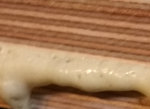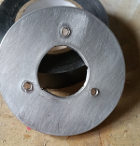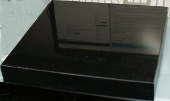Odds and Ends
Polyurethane wood glue for audio equipment.
<img class=" titleimg" alt="pu glue oozing" src="/images/audio/oddsAndEnds/glue-pu-oozing.jpg"/>
Over the past year or so I've pretty much switched from PVA to Polyurethane glue for most tasks. I've discussed this glue with other wood workers and in my favourite hardwood store SL Hardwoods of Croydon and all seem to agree it is a strong glue.
To me it has one very large advantage for audio equipment over PVA; which is that it expands to fill any gaps. So if the two pieces of wood being stuck together have any imperfections that could allow air through the glue will seal it. See the picture below for how the glue expands enough to ooze out of the sides of a joint. However, unlike normal wood glues, it does not stain and can be sanded out. As this glue expands while curing, it is important that the work is well clamped or held under tension while setting. See the example image or the you tube video linked below.
Simple cheap as chips turntable VTA spacer.
<img class=" titleimg" alt="vta adjustment" src="/images/audio/oddsAndEnds/vta-adjustment.jpg"/>
This is probably one of the cheapest things that you can make, and needs just a jigsaw with a metal blade and drill in order to make it. VTA adjusters just extends the height of the arm by a few milimeters and they just need to be made of a solid enough material to ensure the arm mounting is completely firm and has no play whatsoever.
Simple and cost effective component base.
<img class=" titleimg" alt="sub base" src="/images/audio/oddsAndEnds/sub-base-tile-intro.jpg"/>
After doing a bit of tiling, it struck me just how thick the solid marble tiles are, and as I had a few left it struck me that they would make a good base for a component, such as a sub or turntable. In this case, I used a 15mm marble tile, 18mm of MDF followed by 15mm of tile. At the base I used some high quaility speaker feet left over from another job.




